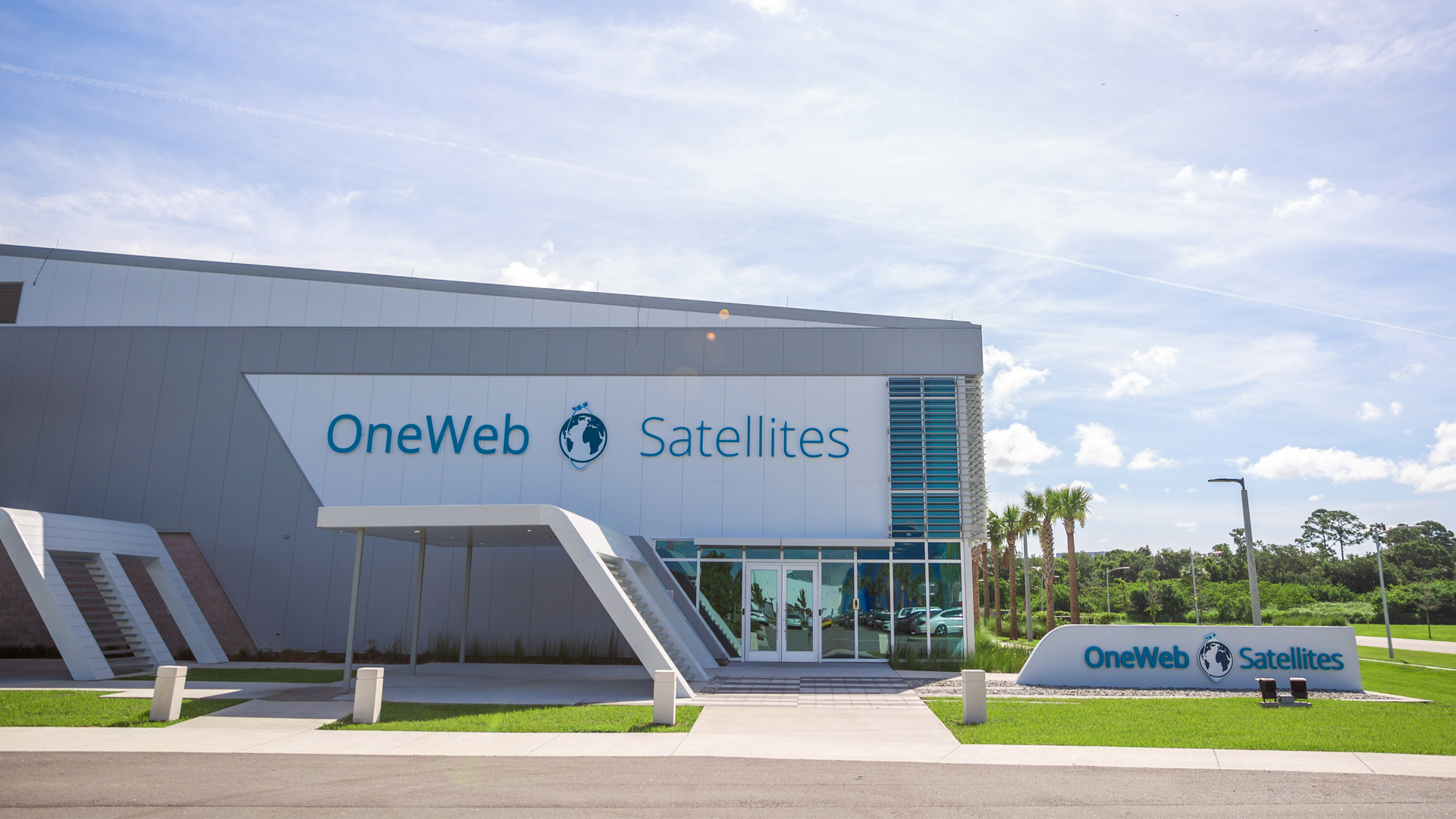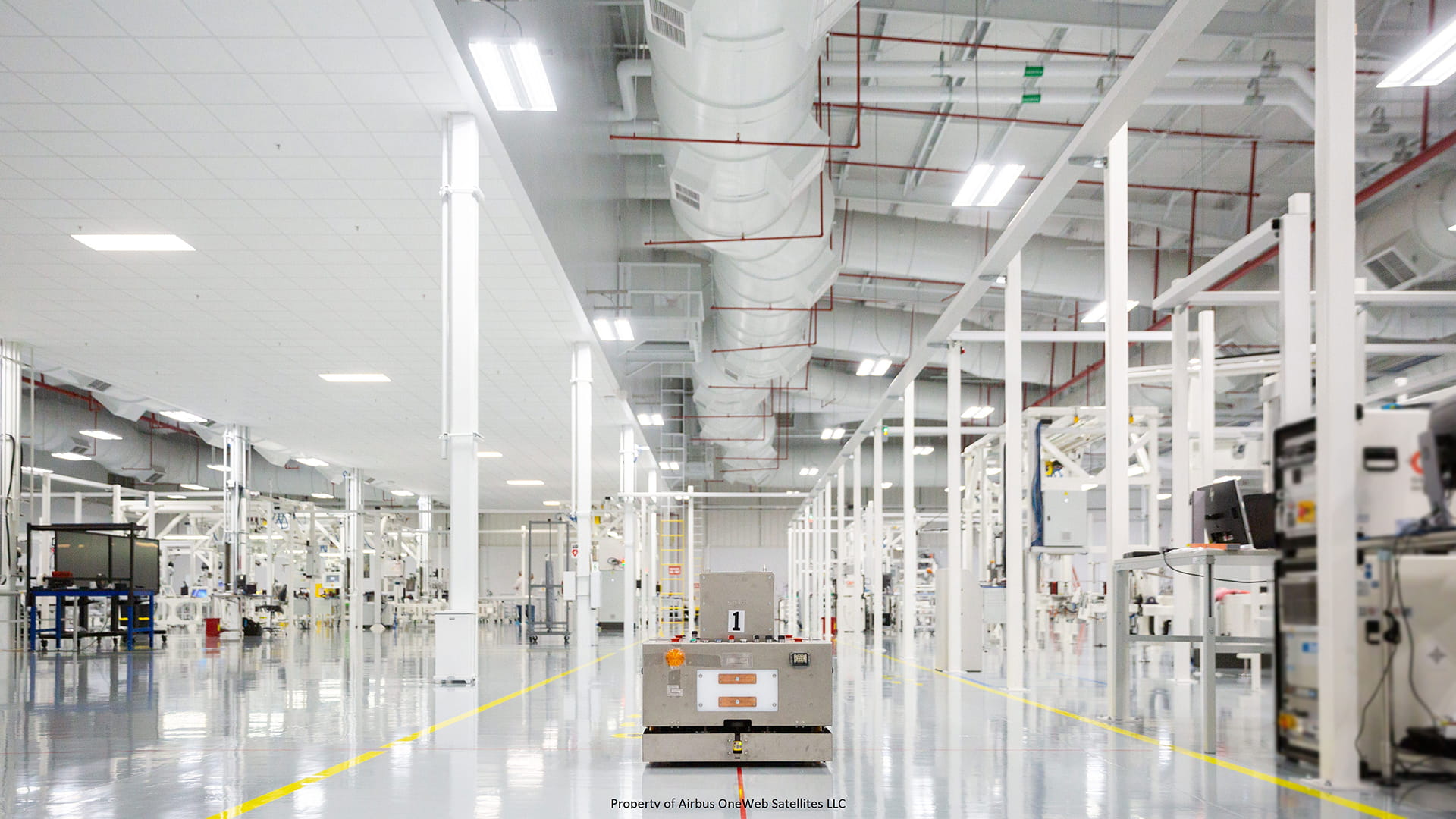OneWeb Satellites plans ground-breaking mass production

Project facts
- ClientOneWeb Satellites
- LocationVirginia, USA
- ChallengeDesigning a satellite factory that mass produces on a scale never managed before, while accounting for complex assembly proccesses.
- SolutionFlexible, user-friendly predictive digital twin software that helps OneWeb take an evidence-based approach to factory design, accounting for the complex assembly process and supply chain.
- ImpactAccurate masterplans for 2 factories that deliver the satellite production required for launch dates.
OneWeb Satellites is a joint venture between Airbus and OneWeb. Its mission is to revolutionise the economies of space, mass-producing a satellite constellation that will provide high-speed internet access worldwide. OneWeb Satellites is a pioneer in high-rate manufacturing of satellites and is running the world’s first satellite serious production line in Merritt Island, Florida.
The challenge
Planning mass production for complex products with complex supply chains
Traditionally, satellites have been designed and manufactured manually on a small scale, with manufacturers building a handful of satellites per year. OneWeb Satellites will produce hundreds of satellites in a year.
Satellite production has never before been managed on this scale. OneWeb Satellites therefore needed to design a factory that delivered the necessary throughput, while accounting for the complex assembly process and supply chain.
Twinn’s WITNESS predictive simulation software play a crucial role in our business forecasting because it enables accurate, system-level thinking. The fact I was able to use this technology from the beginning and embed it in our day-to-day work has made a huge difference."
The solution
Collaboration, flexibility and evidence-based decision making
Airbus divisions had worked with Twinn experts, previously known as Lanner, before and recommended our Witness Horizon predictive simulation software to its partners as the ideal solution for planning satellite production.“We were designing from start-up and needed assurance that what we were creating would deliver products ready for launch dates,” said Gwendolyn Sisto, Operations & Planning Manager at OneWeb Satellites.
“They came for a demo, and it was immediately clear that Witness was easy to use and programme. Compared to other modelling software I’ve used, it’s so much more flexible. You can see it’s designed based on what users actually need. Seemingly little things like the range of variables or the ability to make an input/output file in Excel without hard coding variables in the model – they amount to game changers,” Gwendolyn explained.
Our experts held initial training with the OneWeb Satellites team, taking them through Witness and creating the preliminary model.
“OneWeb Satellites was looking for an evidence-based way to define the factory, and even in the demo version of the model, they could start understanding key aspects,” said Eric Gaury, Senior Consultant at Twinn. “From there, it was easy for OneWeb Satellites to take ownership of the model, develop it and get ongoing value.”
“We got a lot out of the training and from the ongoing support,” Gwendolyn added. “We made a very complex model, which I didn’t realise was even possible at first. We’re constantly learning about additional Witness capabilities and evolving the model. If I need to re-programme or make it more complex, it can be done quickly with their help. This gives us agility, which is crucial for the business.”
The model incorporated a vast range of variables.
“OneWeb Satellites needed to be able to accurately predict satellite production to meet launch dates. They therefore needed to understand how production, automation, quality assurance and supply chain factors affected throughput. Importantly, they needed to account for a learning curve – because the first satellites take longer to make than the 400th one due to efficiency increases over time,” Eric explained.

Impact
An accurate master plan and complete production visibility
Twinn’s Witness experts started working with OneWeb Satellites in 2017, and since then Gwendolyn and the team have used Witness to design 2 factories – an initial one in Toulouse and a subsequent one in Florida.Over the years, they have run hundreds of scenarios. The model has been crucial in designing production flow, understanding utilisation and managing supplier inputs. They have an MRP system to support execution and use Kanban, but the model gives OneWeb Satellites an accurate way to forward schedule, plan subassemblies and ensure the right level of buffer stock for on-time delivery.
“My role was to develop a master plan for satellite production, and Witness has been a crucial strategic tool. The model takes the guesswork out of manufacturing. It continues to play a vital role in our business forecasting because it enables accurate, system-level thinking. The fact I was able to use this technology from the beginning and embed it in our day-to-day work has made a huge difference to our success,” said Gwendolyn.
OneWeb Satellites is now looking at new Witness functionality that integrates the model with the current state of the factory in real time, allowing the company to leverage Industry 4.0 developments to streamline production management as operations reach full capacity.
